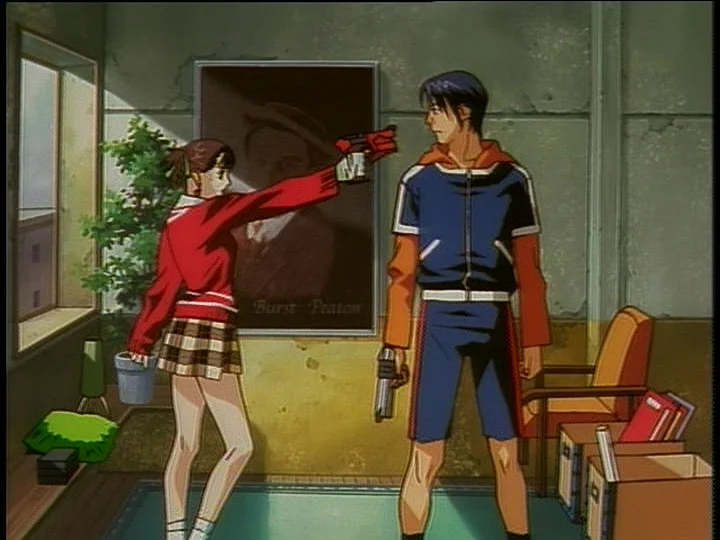“Kite,” also known as “A Kite” (Japanese: A カイト), is a Japanese original video animation (OVA) that has left a lasting impact on the anime world. Written and directed by Yasuomi Umetsu, this film was first released in 1998, with two 35-minute episodes that later merged into a single film for international releases. Known for its provocative content and unique blend of crime and action, Kite has garnered a controversial yet significant place in anime history.
Background of Kite
Yasuomi Umetsu, a renowned Japanese animator and director, is the creative force behind Kite. With a background in producing intense and visually striking works, Umetsu brought a distinct style to Kite. The OVA was produced by Osamu Koshinaka and Tarō Miyabe and animated by the studio ARMS, known for pushing the boundaries of traditional anime content. The music, composed by An Fū, complements the dark and gritty atmosphere of the film.

Plot Overview
Kite follows the story of Sawa, a young orphaned girl who becomes an assassin under the control of corrupt detectives. The narrative dives deep into her tragic life as she seeks revenge while grappling with the loss of her parents. The plot unfolds with intense action sequences, emotional turmoil, and a strong focus on the darker aspects of society. Sawa’s journey is one of survival, vengeance, and the search for justice in a world filled with crime and exploitation.
Themes and Genres
Kite is a blend of several genres, primarily crime, girls with guns, and hentai. The crime element is evident in the storyline, which revolves around corruption, murder, and the underworld. The “girls with guns” genre is highlighted by the protagonist, Sawa, who is depicted as a lethal assassin, skilled in combat and firearms. The hentai aspect, however, has been the most controversial, with explicit scenes that have led to various censored and uncensored versions of the film.
The thematic elements of Kite delve into the darker side of human nature, exploring themes of control, loss, and vengeance. The film’s portrayal of violence and sexual exploitation is meant to evoke strong emotional responses and provoke thought about the consequences of a corrupted society.
Release History and Versions
Kite was initially released on VHS with two separate episodes on February 25 and October 25, 1998. These episodes were later edited and merged into a single film for international audiences. Over the years, the film has seen multiple DVD releases, particularly in North America, where it was distributed by Discotek Media. The international releases often differ from the original, with some versions being heavily censored due to the explicit content.
The uncensored version runs for approximately 53 minutes, while the censored version is slightly shorter at 48 minutes. The controversy surrounding the explicit scenes has led to a rarity in the availability of the full uncensored version, making it a sought-after item for collectors and fans.
Controversy and Reception
Kite’s explicit content, particularly the graphic violence and sexual scenes, has made it a highly controversial anime. The film has been banned or heavily censored in several countries, sparking debates about the boundaries of artistic expression in animation. Despite this, or perhaps because of it, Kite has gained a cult following.
Critically, Kite received mixed reviews. Some praised it for its bold storytelling and striking animation, while others criticized it for the gratuitous nature of its explicit content. Fans of the “girls with guns” genre and those who appreciate darker, more mature anime often regard Kite as a standout piece in the genre.
Kite’s Influence and Legacy
Despite its controversial nature, Kite has influenced various anime and media that followed. Its blend of crime, action, and mature themes has been emulated in other works, particularly within the niche of adult-oriented anime. The film’s aesthetic, characterized by gritty realism and dynamic action sequences, has been praised and replicated by many creators.
Kite’s legacy is cemented by its continued relevance in discussions about the evolution of anime as a medium for mature audiences. Its cult status ensures that it remains a topic of interest for both anime enthusiasts and scholars of animation.
Conclusion
Kite, the 1998 film anime, stands as a testament to the bold and often controversial nature of anime as an art form. Yasuomi Umetsu’s vision brought to life a story that challenges the viewer’s perceptions of morality, justice, and exploitation. While its explicit content may not be for everyone, its impact on the anime industry is undeniable. Kite continues to be a significant work, remembered for its contribution to the crime and girls with guns genres and its enduring influence on anime culture.
By understanding the history, themes, and legacy of Kite, we gain insight into a film that, despite its controversies, remains a pivotal piece in the world of anime.

Akane, known as akanecco._ on Instagram, is a passionate and experienced Anime creator specializing in anime content. With 317 engaging posts and a dedicated following of 12.7K, Akane has become a trusted authority in the anime community. Through detailed reviews, character explorations, and insightful analyses, Akane shares an extensive knowledge of anime, captivating and educating fans with every video. Follow Akane on Instagram to immerse yourself in the vibrant world of anime and join a community of like-minded enthusiasts here- Facebook and Pinterest.





